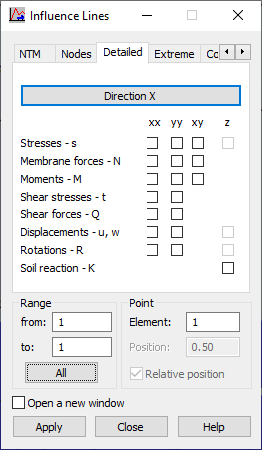After the Detailed tab is selected in the Influence line dialog, the following displays.

The options in the dialog let you indicate a surface-related quantity (defined for a plate or shell structure) for which the influence lines are presented:
- Stresses in the local element-related coordinate system sxx, syy, sxy, and sz
- Membrane forces in the local element-related coordinate system Nxx, Nyy, and Nxy
- Moments in the local element-related coordinate system Mxx, Myy, and Mxy
- Shearing stresses in the local element-related coordinate system txx and tyy
- Shearing forces in the local element-related coordinate system Qxx and Qyy
- Displacements in the local element-related coordinate system uxx, uyy, and w
- Rotations in the local element-related coordinate system Rxx, Ryy, and Rz
- Soil reaction Kz
The top of the dialog has the Direction button. It lets you define the main direction of the coordinate system (direction of the x axis x). All the resultant values are calculated in this rotated coordinate system. You select the direction in the Direction dialog, where you can select any vector that defines the main direction for determining the results of surface elements calculations. The selected vector is projected on the element, which defines the local direction of the x axis. There is a limitation to selecting the direction. The main vector cannot be perpendicular to the element (that is, parallel to the local z axis). If you select such a direction (the projection of the vector is a point), all the results will be zero.
